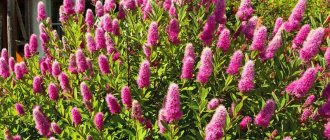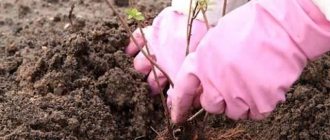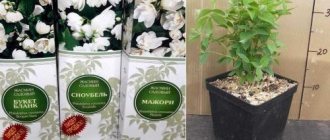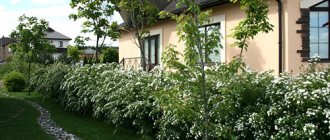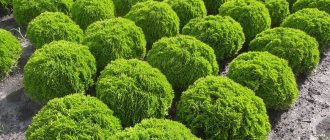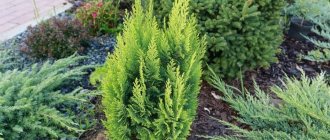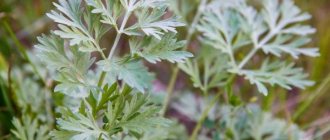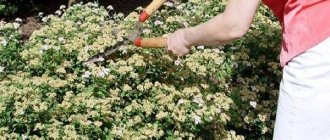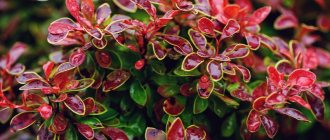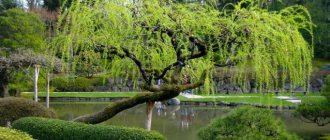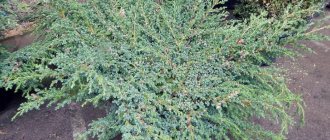Rules for planting and subtleties of caring for shrubs
Spiraea bushes can be planted in spring or autumn.
It is important to choose quality material and follow planting rules
Selection and purchase of seedlings
It is better to buy seedlings in specialized stores or nurseries. They must have the following characteristics:
- roots are fibrous, fresh and elastic;
- the shoots are smooth, the bark is not damaged;
- when purchased in autumn, the leaves are evenly colored, without spots;
- In spring, the buds should be swollen, but not bloomed.
Before planting, bare-rooted seedlings are soaked in a growth stimulator. Plants in containers are watered so that the rhizome can be easily removed along with a lump of earth.
Seedlings are sold in specialized stores or nurseries
Site selection and soil preparation
Spiraea bushes are photophilous. They can also grow in the shade, but there will not be lush flowering. They are not demanding on the composition of the soil, but the best decorative properties are shown on well-drained loams with neutral or high acidity.
Interesting fact. On acidic soils, autumn foliage color becomes brighter and more saturated.
Planting holes 40-50 cm deep are dug in advance. Their width should be 1.5 times the diameter of the roots. A drainage layer of 10-15 cm is laid at the bottom. The earth is mixed with humus, filled back to half, and left for a couple of weeks. When planting several bushes, a distance of 70-80 cm is maintained between them.
Planting process and propagation methods
Planting bushes occurs as follows:
- The seedling is placed in the hole so that the root collar is at soil level.
- The hole is filled with earth, compacting it periodically.
- At the end, the seedling is watered abundantly, making a furrow around the hole.
Planting a seedling in open ground is carried out in spring or autumn. Reproduction of spirea is possible in three ways:
- seeds - they are collected in October, dried and sown for seedlings in the spring after 1-2 months of stratification;
- layering - for this purpose, a strong side shoot is dug in in the spring, and a young bush is planted in the fall;
- cuttings - blanks 10-15 cm long are cut in late spring or summer, rooted in greenhouses at high humidity.
Watering and fertilizing
The plant does not tolerate prolonged drought, so watering is carried out once every 2 weeks at the rate of 1.5 buckets of water per bush. To prevent moisture from evaporating, the soil is mulched, and if there is no mulch, it is loosened. When the air temperature drops to +10 °C, watering is stopped.
Spirea is fed twice during the season: in the spring, immediately after pruning, and before flowering. For the first feeding, use liquid mullein with the addition of superphosphate (10 g/bucket of solution). The second time potassium-phosphorus fertilizers are applied.
Agricultural technology for growing birch leaf spirea: rules and care features
Caring for birch leaf spirea includes the main steps, when done correctly you will be able to grow a beautiful and flowering plant.
- Watering. It is important to remember that although this type of spirea is considered a drought-resistant plant, it is necessary to strictly adhere to the watering regime. It is enough to pour 1.5-2 buckets of water under each plant once every two weeks for the bushes to feel great and bloom beautifully. If the temperature drops to +10 degrees, all watering stops.
- Loosening and mulching. After each watering, the soil around the plants must be loosened, but this must be done carefully so as not to damage the root system. To reduce the number of waterings and reduce the number of weeds, the tree trunk circle can be mulched with peat.
- Feeding. Birch leaf spirea bushes are fertilized twice a season. The first time this is done in the spring and a solution of mullein with the addition of superphosphate is applied under each bush, and the second time feeding is carried out in early summer before flowering. In this case, it is necessary to use potassium-phosphorus fertilizers.
- Pruning birch leaf spirea. Pruning is an important stage in caring for this crop. Every spring, before the buds swell, it is important to carry out sanitary pruning, removing all damaged branches. Old shoots must be removed completely, cutting them off near the ground. Young shoots are shortened to the first outer bud. When the plant reaches 4-5 years, all branches are shortened to a height of 25-30 cm, thereby rejuvenating the bush.
- Shelter for the winter. Spiraea birch leaf, like most other species of this crop, is considered a frost-resistant plant that tolerates cold and harsh winters. Therefore, before the onset of winter, it is enough to mulch the bushes with peat and fallen leaves.
Tips for caring for flowers
During the growing season, spirea needs to be properly cared for, then the size of the shrub will increase and flowering will be long. Care includes the usual set of activities - watering, fertilizing, pruning.
Watering
Recommendations for watering spirea:
- 10-15 liters of settled warm water are poured into the root circle.
- The water application mode is 2 times a month.
- During the peak summer season, in the absence of rain and high air temperatures, water twice a week. It is better to water in the evening or early morning.
After the top layer has dried, the soil is loosened to a depth of 7-8 centimeters, trying not to damage the roots. During the rainy season, watering is reduced - spirea does not need excess moisture, as mold and root rot can develop. Remove weeds regularly.
Top dressing
The first time spirea is fed after spring pruning to ensure the growth of branches and green mass. Apply diluted manure or bird droppings combined with superphosphate (8-10 grams per bush). Secondary feeding is done at the beginning of budding, adding a potassium-phosphorus-nitrogen complex (Kemira Universal).
Trimming Features
The spirea bush grows quickly; to maintain the decorativeness and health of the plant, several types of pruning are used:
- Spring (main). Dead branches, frostbitten tips, and diseased, damaged parts of the bush are cut out.
- Decorative. It is carried out in early spring - the shoots are cut by a third, choosing one of 2-3. The bush is given the desired shape so that it pleases with its appearance.
- Rejuvenating. A necessary measure for plants aged 7-10 years. The branches should be cut at the root, close to the ground, leaving the lower dormant buds. In the future, young shoots will grow from the old root, and the bush will be completely renewed.
When formative pruning, you should not remove only old shoots, otherwise the young branches will not produce abundant flowering.
Transfer
If it is necessary to transplant spirea, a hole in a new place is prepared in 5-7 days. The main thing when replanting is to remove the bush without greatly damaging the root system and preserving the earthen lump. Spiraea is dug up from all sides, the plant is removed with soil and transferred to a new place on fabric. The earthen ball with the bush is lowered into the hole, aligning the growth points with the soil surface. The plant is shed with water with a dissolved growth stimulator (Kornevin). In dry weather, the bush is covered with a large piece of wet cloth for 3-5 days, constantly maintaining humidity.
Preparing for winter
Spiraea has a large reserve of frost resistance. To prevent the root system from freezing due to a lack of snow, the soil around the plant in winter must be covered with a layer of mulch (peat, hay, foliage). The ends of branches damaged by frost are pruned in the spring.
Planting and care
Almost all types of spirea belong to unpretentious park plants with a simple description of agricultural cultivation. The birch-leaved type is no exception and feels good in parks, squares and garden plots, without requiring special care.
Site selection and planting scheme
This species is planted in places with good lighting and good drainage.
This could be the following area:
- hillside;
- small valley;
- alpine slide;
- the area along the curb at the entrance to the house;
- house lawn.
Planting can be done either as a tapeworm (single bush) or sequentially in the form of a hedge. In the second case, seedlings are planted in rows every 0.5 m with a distance between plants in a row of 0.4 m. Group plantings are also beautiful - bushes are planted in a checkerboard or random order every 0.5–0.7 m.
Planting is done in September in cloudy, foggy or rainy weather. The hole should be one third wider and deeper than the diameter of the seedling's root system. Broken brick or vermiculite is placed at the bottom to drain excess moisture.
After this, the bush is placed in a hole and sprinkled with soil up to the root collar. The soil must be carefully compacted with your hands or garden tools.
Watering
Spirea needs to be watered 1-2 times a month, using 10–20 liters of water. On rainy days, watering should be stopped and moisture should be monitored for removal from the root zone. After watering, it is necessary to mulch the soil with sawdust or leaves. After natural precipitation, the soil is loosened and also mulched.
Fertilizers
The bushes are fed twice during the warm season - in early spring, after pruning and before summer, when the plant is about to bloom. In the spring, organic fertilizers are applied - mullein with humus in a ratio of 1:5 or just humus.
Before flowering, specialized fertilizers for flowering shrubs are applied. Before putting the bush to sleep for the winter, you can mulch its root zone with peat, organic fertilizers or healthy leaves of the plant itself.
Plant pruning
Spirea should be pruned in late autumn, when the movement of sap in the branches stops.
The following parts of the bush are subject to pruning:
- thickening branches growing inside the crown;
- weak and diseased shoots;
- drying branches spoiling the appearance;
- old woody shoots.
Excess shoots are removed with a sharp knife or pruning shears; it is better to take the rejected material outside the garden or park area and burn it. Old branches are removed close to the ground, young shoots are cut 30 cm above the ground.
Reproduction methods
Each gardener chooses for himself the most convenient method of growing birch-leaf spirea.
Cuttings
You can cut shrubs in autumn. During the procedure, branches that grow vertically upward, are young, and have already become lignified are cut. After this, only the apical leaves are left and the branch is placed in the solution for root formation. The cuttings are planted in containers with moistened sand with a slight slope. In the fall, they are buried in the ground and covered until spring planting.
By layering
An easy way for beginning gardeners is to obtain cuttings. The lower healthy shoots of the bush need to be dug into the soil under the mother plant in prepared shallow holes, and, securely fastened, constantly moisten the trunk circle of the adult bush.
Along with this, other agricultural work can be carried out, but with caution, trying not to damage the process of root formation in the future seedling. For the winter, the ground is mulched, covered with protective materials, and the shoots with roots are separated in the spring, at which time they are planted in open ground
Dividing the bush
This way you can get cuttings from plants aged 3-4 years. In the fall, water the ground under the spirea well, dig in a circle, remove the bush and divide it into several parts with a sharp tool. Each must have an intact trunk and strong roots. Shrubs can be planted in the soil, but in the winter they will have to be carefully covered to prevent freezing.
The seed method is not very popular because it takes a lot of effort and time.
High quality seeds are very important, otherwise they may not germinate. Seedlings are sown in the spring, having previously carried out antifungal treatment and stratification.
In greenhouse conditions, the seeds germinate and are then planted. It is better to move young plants to greenhouses for the winter and plant them in a permanent place next spring.
How to plant spirea correctly in the fall
Unlike the spring season, both groups of plant varieties can be planted in the fall. Most often, they are planted simultaneously with dividing the bush. Young plants, no older than 4 years, are best suited for this. Otherwise, it will be very difficult for you to remove a large ball of earth and wash the soil out of it.
Dig up a spirea bush. Don't be afraid to chop off the roots a little - this won't cause much harm to the plant. Rinse the earthen ball, clearing the roots from the soil. If you dug up a very young plant, then it will be enough to simply place it in a container of water and wait until the earth settles at the bottom. When the roots are ready, divide the plant with pruning shears so that each part has strong roots and a couple of main branches.
Now you know how to plant spirea correctly.
Specifics of cultivation
Gray spirea has a non-capricious disposition; gardeners note the plant’s unpretentiousness and ease of care.
When planting, it is important to remember that the branches grow up to 15-25 centimeters per year; a small seedling will soon turn into a shrub, which can reach 3 meters in girth. This must be taken into account when choosing a planting scheme, planning use for a hedge or next to other plants.
When to plant?
The best time for planting in open ground is considered to be the beginning of autumn - cloudy rainy weather. If the seedling is planted in the spring, you need to do it before the buds open. Spiraea takes root easily; flower growers believe that a seedling from a pot with a lump of earth will take root when planted at any time, the main thing is to water and lightly shade the young sprout from the sun at first.
How to plant?
Spiraea, growing in the sun, has a symmetrical, lush bush, blooms profusely and for a long time. For shrubs, it is better to choose open sunny places, allowing only slight shading. Heavy soil is lightened with humus, dry leaves, and peat. The pit is prepared several days before planting. A drainage layer of small stones is placed at the bottom to ensure that excess water escapes. The size of the pit is 40-50 centimeters.
A layer of prepared fertile soil is poured over the drainage. The roots of the seedling are trimmed, and areas that are too long and damaged are removed. Place the young sprout in the center of the hole so that the growth point coincides with the surface of the soil, and cover it with soil and compact it. Spill water (a bucket) and, if necessary, level the seedling in the hole. The soil surface is mulched with organic matter.
Landing rules
Although the plant is considered unpretentious, it is still recommended to choose a well-lit place for it. The bush will grow in shade or partial shade on the north side, but most likely do not expect lush flowering.
Selecting a location
Autumn is a good time to plant birch leaf spirea. Experts do not advise it in the spring, since the root system is already well rooted and adapting, and in the summer the bush may even begin to bloom.
- The best time would be September, when the heat has subsided, but it is still quite warm. The soil should be well moistened, and choose a cloudy day with even light precipitation.
- The soil must first be cleared of weeds and thoroughly loosened.
- It is recommended to add humus to the soil. Fertile and acidic soil promotes lush flowering.
Planting in open ground
It is best to purchase seedlings in containers with fertilizers. Then the young bush can be transplanted directly with a clod of earth into open ground. This method is convenient because the root system will not be injured.
- First you need to dig a planting hole. The size should exceed the diameter of the seedling's root system by about a third. A depth of half a meter will be sufficient.
- Depending on how you plan to plant the spirea seedlings, the distance between the holes can range from 40 cm to one and a half meters.
- If the soil is very clayey, then a hole should be dug several times larger than the root.
- Be sure to place a drainage layer at the bottom of the hole, which will allow air to pass through and not retain excess moisture. It can be made using broken bricks, gravel, sand, peat, as well as turf or leaf soil.
- When planting, the roots of the seedling should be carefully straightened, and then covered with earth, compacting it very slightly.
- Before planting, the root system must be thoroughly inspected and dry and broken shoots must be removed.
Features of the spirea bush
Spiraea are found both quite tall (about 2.5 m) and miniature (about 15 centimeters). There is a fibrous, not very deep root system. Branches can be either erect or creeping, lying or spreading. They can have a color from dark to pale brown. The bark can peel off longitudinally. Petiolate alternately arranged leaf plates have from 3 to 5 lobes and a round or lanceolate shape. Spiraea inflorescences consist of a large number of small flowers, and they can have a spicate, corymbose, paniculate or pyramidal shape. Flowers can be painted in various color shades from crimson to snow-white. The arrangement of inflorescences directly depends on the species. Thus, there are species in which they are located throughout the stem, in others - only in the upper part, and in others - only at the ends of the branches. Meadowsweet can be propagated by layering, seeds, dividing the bush or cuttings.
This plant is great for creating hedges, as well as for group plantings. At the same time, dwarf varieties are widely used for rocky gardens, rockeries, and also for living “carpets”. Also, the meadowsweet bush looks very impressive as a single plant.
- https://fermilon.ru/sad-i-ogorod/dekorativnye-kustarniki/spireya-berezolistnaya-posadka-i-uhod-foto.html
- https://yellowhome.ru/2016/10/29/spireya-yaponskaya-osobennosti-razvedeniya/
- https://stroy-podskazka.ru/spireya/vidy/berezolistnaya/
- https://naogorode.net/spireya-berezolistnaya/
- https://sornyakov.net/trees/spireya-berezolistnaya.html
- https://7dach.ru/eleko/ryabinnik-chetyre-cveta-za-sezon-134259.html
- https://glav-dacha.ru/foto-i-opisanie-sortov-spirei/
- https://dachnaya-zhizn.ru/spireya-berezolistnaya-posadka-i-ukhod
- https://rastenievod.com/spireya.html
Spiraea birch leaf: photo, description, varieties, planting and care
Photos and descriptions of birch leaf spirea, the most popular varieties of the species, will help you decide which specimen is suitable for the design of a particular garden.
The plants also have a second name - meadowsweet, but descriptions more often mention the beautifully flowering spirea shrub.
An unpretentious, hardy and winter-hardy plant does not require particularly complex care, and is not picky about soils. Meadowsweet also grows in shade, although it blooms little.
Spiraea birch leaf in landscape design
Meadowsweet is shade-tolerant, but in a well-lit place the bush blooms more profusely. This fact is taken into account when planning to plant shrubs in the garden. Birch leaf spirea, judging by the photo, is a plastic plant with which original impressive compositions are created:
- edges near tall decorative deciduous trees or shrubs;
- contrasting accentuation of conifers, which looks expressive during flowering and autumn;
- landing on the alpine slides;
- bordering rockeries;
- mixborder element between other shrubs and flowers;
- low-growing hedges made from dwarf varieties of meadowsweet for garden zoning;
- a colorful soloist element near the entrance to another area of the garden or courtyard.
The plant is valued as a generous honey plant and an active source of phytoncides. Landscape designers note the harmonious combination of birch-leaved meadowsweet bushes with lilacs, roses, perennial asters and conifers.
Attention! On acidic soils, spirea leaves turn bright colors in autumn.
Varieties of birch leaf spirea
Breeders have developed original forms of birch leaf spirea.
Spiraea birch leaf Thor
The Thor variety bush is low, up to 70 cm-1 m, spreading, spreading up to 1.5 m. The crown is dense, compact, formed from vertical shoots in the form of a hemisphere.
According to the description, birch-leaved spirea Tor is picturesque even without flowers, thanks to its dark green leaves with a steely sheen. In autumn the bush is painted in yellow tones. Blooms in June and early July.
The buds bloom with light cream petals, collected in inflorescences 5-6 cm long. Sometimes at the end of August the bush re-blooms.
Spiraea birch leaf Thor Gold
The birch-leaved spirea variety Tor Gold also has a compact bush, 65-100 cm high. The crown is spherical and dense. Blooms profusely in mid-summer for 25-26 days. Corymbose inflorescences are white.
The decorative effect of birch-leaved spirea bushes Spiraea betulifolia Tor Gold consists of the impressive shades of autumn leaves. In summer, the foliage of the variety is light, yellow-light green. It’s not for nothing that the authors compared the overall shade of the bush with the shine of gold.
From August, the leaves acquire bright nuances of yellow, orange, red-crimson, even purple-violet.
Spiraea birch leaf Iceland
The variety of birch-leaf spirea Spiraea betulifolia Island is taller than others: the shrub rises from 1 m to 1.5 m. Dense spherical crown with a diameter of up to 1.5-1.8 m. Flowering is long, from June 15-16 to August. The inflorescences are white-cream, standard for the species.
Spiraea birch-leaved Island is very beautiful in autumn. Repeated flowering of bushes in sunny areas often occurs, although less abundant than in summer. The crimson-purple color of the leaves is impressive.
During this period, attention is focused on the bright spots of spirea bushes in the garden or against the background of a dark wall of coniferous plants.
Advice! The second, autumn, wave of flowering is provoked by a skilled gardener who promptly removes the wilted scutes on the plant.
Spiraea birch leaf Pink Sparkler
The bushes of the new variety are low-growing, only 50-60 cm. The value of birch-leaved spirea with pink flowers is in the colorful and spectacular effect when the buds open.
The flowering of the dwarf meadowsweet bush is long, from June to August. So far this is the only birch-leaved variety with pink petals. Like all spirea, the bushes of the variety are light-loving and moisture-loving.
The qualities are standard for the species: an unpretentious, winter-hardy ornamental plant.
Planting and caring for birch leaf spirea
Hardy ornamental meadowsweet bushes are planted in spring and autumn. In the middle zone of the country, it is better to plant spirea from the beginning of September, in cloudy weather. Meadowsweet seedlings with an open root system are moved in September or April, when the buds have not yet opened.
Bushes from nurseries in containers take root at any time, but they need to be provided with shading during hot weather and regular watering. Any soil with a neutral structure, with acidity up to pH values of 5.6-7.8, is suitable for planting colorful meadowsweet shrubs. It has been noted that meadowsweet develops best on moist, drained loams.
Beautiful abundant flowering and a bright shade of pink petals are observed in well-lit areas or in light partial shade, which falls on the bush especially at lunchtime. The shade of the leaves also depends on the amount of sunlight, which becomes more intense in bright light.
Autumn foliage color, rich in dark reddish tones, is observed in places where the soils are more acidic.
If meadowsweet bushes are placed as a hedge, the interval between them is 50 cm. In group plantings on ridges, at least 70-80 cm are spaced between the holes.
Preparation of planting material
When buying a spirea bush, pay attention to the appearance of the seedling:
- exposed roots are fibrous, elastic, fresh to the touch;
- the stems are smooth, straight, without damage;
- in autumn the leaves are fresh, without signs of disease, with an even color;
- In spring, the buds are swollen or slightly opened.
Having been delivered to the site, the spirea seedling with bare roots is soaked before planting in a liquid solution of clay or with an added growth stimulant, following the instructions supplied with the preparation. Seedlings in containers are placed in a large bucket of water so that the roots can be easily removed along with the earthen ball.
Watering and fertilizing
Spiraea loves to grow in the sun, but does not tolerate prolonged drought. Systematic watering is organized for the bush. It is enough to pour out 1.5-2 buckets of water, depending on the size of the plant.
Meadowsweet is watered infrequently - 2 times a month, if there is natural precipitation. The wet soil is mulched to maintain a loose structure. Or loosen after each watering.
Feed beautifully flowering meadowsweet bushes 2 times per season:
- after spring pruning;
- before flowering.
In the spring, meadowsweet is fertilized with organic matter: humus or mullein diluted 1:5. This infusion is dissolved in advance and 5-10 g of superphosphate is added. Instead of organic fertilizers, chemical agents are also used, where the nitrogen component predominates.
At the end of May or at the beginning of June, they are fed with potassium-phosphorus preparations, for example, potassium monophosphate. It is convenient to use balanced complex fertilizers for flowering shrubs.
In autumn, the tree trunk circle is also mulched with humus or peat, leaves, which are partially converted into fertilizers.
Pruning birch leaf spirea
Pruning is carried out, as for many plants, in early spring, before the buds wake up. Remove old shoots that are more than 6-7 years old, cutting them off at the bottom, near the ground. Young shoots are cut evenly, collecting several pieces in a bunch.
This is how the crown is formed. The tops are cut down to the outer buds, which are better developed. Small branches are removed completely. At 4-5 years, the stems are shortened to 30 cm above the soil.
They usually produce numerous new shoots, which make the bush more lush.
Important! Lack of pruning leads to drying out of the tops of the bush.
The next pruning is to organize the birch leaf spirea bush after flowering. Withered panicles are removed so that the plant does not waste energy on producing fruits. And at the same time, its appearance improves when the autumn colors of the leaves come into the picture. Strong bushes after 10-12 years of growth are cut off completely for rejuvenation.
Important! When pruning spirea branches, make sure that the top one remains the bud that grows outward.
Reproduction
Meadowsweet bushes are propagated by:
- layering;
- cuttings;
- seeds.
Meadowsweet is easily propagated by layering, which is replanted the following spring. If you use a root formation stimulator, all spring and summer cuttings will take root. They are placed in a sandy substrate in mini-greenhouses and provided with humidity. Seeds are sown in spring; stratification is not carried out. 65% of the sown seeds germinate.
Conclusion
Photos and descriptions of birch leaf spirea, which emphasize the easy care of the attractive shrub, make you want to plant the plant in your garden. Meadowsweet will be decorative in any way. Rare watering, fertilizing and proper pruning will result in lush flowering.
Source: https://fermilon.ru/sad-i-ogorod/dekorativnye-kustarniki/spireya-berezolistnaya-posadka-i-uhod-foto.html
Description of the plant and photo
Birch-leaved spirea (Spiraea betulifolia) belongs to the ornamental deciduous, flowering shrubs of the Rosaceae family. The plant's habitat is Eastern Siberia, the Far East and Asian countries. Spiraea birch leaf is one of the most striking representatives of the genus, does not lose its attractiveness throughout the year, and is resistant to drought and severe frosts.
The culture has the following botanical description:
- Low-growing compact shrub up to 0.6-1 m high.
- The root system is powerful, branched and short.
- The crown is spherical or slightly elongated, reaching 0.7-1 m in diameter.
- The shoots are erect, densely spaced. Young branches have a ribbed surface and a reddish tint; they are often zigzag-shaped; with age they change their color to brown.
- The leaves are decorative, densely covering the branches. The leaf blades are oval, broadly ovate, with a jagged edge and well-defined veins on the inside. The foliage is medium in size, up to 5 cm in length, colored bright green, with the inside being lighter than the outside. In autumn, the leaves acquire a bright yellow color, and when grown in acidic soil, they can be a more saturated and bright red-purple hue.
- The inflorescences are corymbose, consisting of 20-100 flowers. The flowers are five-petaled, about 7-9 mm in diameter, and depending on the variety, can be cream, white, deep pink or slightly pink. They bloom at 3-4 years of age in mid-June and delight with their color for a month. This distinguishes this species from other spireas that bloom in spring.
- Fruits with seeds ripen in early October.
Description of birch leaf spirea
The height of birch leaf spirea is from 50 to 80 cm, the crown is usually of the same diameter. The spherical crown is decorative throughout the warm season. Old branches are brown, young branches are ribbed, with a reddish tint, are zigzag curved, and have an average growth rate. Birch-leaved spirea, in Latin - Spiraea betulifolia, received its specific name, since its broadly ovate, serrated leaves with a wedge-shaped base are similar to birch leaves. Their dimensions are 2.5-4.5x1.5 cm. The leaves are bright green, lighter below, protruding veins are visible. Light-loving meadowsweet begins to bloom from 3-4 years of development. In the middle climate zone, the buds bloom from the second ten days of June, the flowers last until the beginning of July. Corymbose inflorescences with a diameter of 3-9 cm, dense, consist of 20-100 small 5-petal flowers 7-9 mm wide. The petals are white, cream, slightly pinkish or deep pink depending on the variety. The seeds ripen by early October. If seeds are not needed, faded inflorescences are cut off to make the bush more colorful.
In autumn, birch-leaved spirea is also picturesque. The leaves turn an intense yellow or take on a bright blush depending on the minerals in the soil. Meadowsweet can withstand frosts down to -29-34 °C without shelter. The plant remains decorative for 15-20 years, then the bush is changed or rejuvenated by pruning at soil level.
Reproduction of spirea in spring by dividing the bush
Reproduction of spirea is carried out in several ways: by dividing the bush, seeds, layering and cuttings. The first method is considered the most optimal and fastest. We will tell you how to propagate spirea in all ways.
A quick way to get a mature plant. Spiraea is propagated by dividing the bush if the plant has reached the age of 4 years. It is divided into several smaller shrubs. If the plant is older, then this method will be extremely labor-intensive: the roots have grown and formed a powerful system. Because of this, it becomes extremely difficult to remove the bush from the ground and divide it.
Dig up the bush based on the size of the crown, plus half a meter. Don't worry if you damage a few roots during this process.
The root system must be dipped in water for several hours, until part of the soil settles. Wash the remains under running water. This is necessary so that the earth does not interfere with the division of the bush into parts. Otherwise, due to carelessness, you can damage the roots or separate them unevenly, as they tend to intertwine.
Divide the bush. Each piece should have a couple of main branches and a good root system. After this, the plant needs to be prepared for planting. The roots should be made the same length and small shoots should be trimmed.
Immediately after planting, the plant must be watered abundantly. If it is hot summer outside, then you need to water every day, and in cool weather - once a week. If there is enough moisture, the plant will quickly take root and will actively develop.
If the bush has outgrown the age of 4 years, then you should use other methods.
Subtleties of growing crops
In order for birch leaf spirea to grow decoratively and bloom profusely, you need to plant it correctly. There should be a fairly large distance between the bushes, since they have a spreading crown: between tall varieties - about 1 meter, between short ones - up to 80 centimeters. If plants are planted as a hedge, the distance between them is maintained in the range of 30-50 centimeters.
Landing dates
Birch leaf spirea can be planted in open ground in early spring and autumn. When planting in spring, there should be no signs of vegetation on the bushes. In autumn, spirea is planted from mid-October to mid-November. At the same time, overgrown bushes are planted. Shrubs grown in containers can be planted at any time, but shade them with burlap on hot afternoons.
Planting and caring for perennial coreopsis, TOP 25 varietiesRead
How and where to plant?
Spiraea birch leaf prefers well-lit places with breathable soil. The brightness of the leaves depends on the level of illumination. Plants are planted in cloudy weather. The substrate is prepared from the following components:
- leaf and turf soil;
- heavy soil is lightened with peat and sand;
- Clay is added to sandy soil.
The root system is inspected before planting: if there are broken or rotten roots, they are removed with a sharp knife. Shoots that are too long are shortened by a third. Planting birch leaf spirea is done as follows:
- A hole is dug in volume 2 times larger than the root system of the plant. The planting hole should settle a little, so they begin to prepare it 2 weeks before planting the spirea.
- Expanded clay, broken shards, and small stones are placed on the bottom. The drainage layer must be at least 10 centimeters.
- The prepared substrate is poured on top, and a bush is placed in the center of the hole. Next, the soil is poured out so that the root collar is level with the ground.
- The substrate is slightly compacted and watered.
To ensure that the soil retains moisture and prevents weeds from growing, it must be sprinkled with mulch.
What kind of miracle is growing in the yard?
Before talking about any specific species, and there are about ninety of them, it is worth finding out general information about this plant. Below is a photo and description of spirea. Look how beautiful this is, isn’t it worthy to take pride of place in your garden plot?
Plant forms are varied. It is impossible to list everything, but here are some of them:
- similar to a pyramid;
- resemble a hemisphere;
- erect;
- have the appearance of a cascade;
- creep along the ground;
- weeping and others.
The height of spirea does not exceed two meters. A plant of one species differs from a plant of another only in the shape and color of its leaves. Most varieties change color by autumn. Green leaves turn purple-red, yellow or orange. As you can see in the photo, spirea in garden design is its real decoration. And if you correctly select and plant several species of this plant on your site, then it will delight you with its flowering from spring to late autumn.
Spiraea flowers are small, but their number is huge and they are combined into inflorescences of different shapes:
On this topic:
BACK
FORWARD
1 of 93
- paniculate;
- spicate;
- corymboses;
- pyramidal;
- single.
The color of the flowers can be pure white and gradually turn into crimson.
Description and characteristics
Birch-leaved spirea is a low-growing deciduous shrub. Its height varies from 50 to 80 centimeters; the crown spreads over the same distance. The plant got its name from its leaf blades, which have the same serrations as birch leaves. They are oval in shape, with a wedge-shaped base, and green in color, with prominent veins.
Spiraea begins to bloom at 3-4 years of age. Inflorescences, consisting of 20-100 flowers, come in cream, white, and pink colors. By autumn, the green leaves turn yellow-red. The plant is frost-resistant, can withstand temperatures down to -35 °C.
Fertilizer and plant nutrition
It is recommended to feed Japanese spirea twice a year:
- in the spring, after pruning the bushes, use complex fertilizer according to the instructions attached to it;
- in summer during flowering - with organic fertilizer, adding superphosphate, which improves the formation of new inflorescences.
Mullein can be used as an organic fertilizer, which is diluted with water in a quantitative ratio of 1:6. In the absence of cow manure, it is replaced with chicken manure, diluted with water 1:18. It is enough to take 10 g of superphosphate per bucket of the resulting solution.
Plants also receive a certain amount of nutrients from the mulch located under the bushes. It not only prevents the formation of a dense crust on the soil surface, improving root aeration, but also enriches the soil, being processed by earthworms living in it. The same function will be performed by laying fallen leaves on the surface of the soil adjacent to the stems of the plant in preparation for winter. It will also insulate the roots of the plant, protecting it from damage during severe frosts.
Reproduction
Depending on the type, spirea is propagated in different ways:
- cuttings - green, semi-lignified, woody;
- horizontal layers;
- bush divisions;
- seeds.
Some species (Vangutta) do not produce seeds and reproduce only by shoots.
Planting shoots
The easiest way to propagate spirea is to transplant shoots that appear next to adult bushes. The soil is dug up and the young shoot near the root is cut off. The young plant is immediately planted in the ground or, if its root system is not sufficiently developed, in a pot.
Green cuttings
Another method of propagation is by cuttings. The stems are green or semi-lignified, but still flexible, cut in summer. The cuttings are dipped in rooting agent and planted in peat mixed with vermiculite. Caring for cuttings requires constant monitoring of proper soil and air humidity. Typically, spirea cuttings have no problems with rooting.
The pot with cuttings should not be kept in full sun. Cuttings from semi-lignified shoots are covered with film. The film is spread on wires or sticks buried in the ground so that it does not touch the cuttings.
Woody shoots are cut in the fall, when the plant sheds its leaves. Lignified cuttings are not as susceptible to drying out as semi-lignified ones. It is necessary to provide them with a low temperature in winter, and in the spring they are put into school. Young spirea are planted in a permanent place after 1-2 years, when a strong root system develops.
Lignified cuttings
Caring for woody cuttings requires less effort. In an adult plant, lignified shoots are cut off and cut into cuttings.
Drawing:
1) correctly cut cuttings, 2) depth of placement in the ground, 3) rooted seedlings.
The tops of the cuttings are placed at the same level with the surface of the substrate. The optimal temperature for root development is 22-26 °C. Young plants are planted in individual pots when their roots are 2.5 cm long - usually after 6 months. Before planting in a permanent place, seedlings are hardened in a greenhouse for 3 weeks.
Possible diseases and pests
Birch leaf spirea rarely gets sick, but if there is too much rainfall during the season, it can become infected with fungal diseases. If rot is detected on the plant, it must be treated with a fungicide. To prevent diseases in early spring, bushes are sprayed with Bordeaux mixture.
Bushes can be overcome by insects such as aphids, rose leaf miner, spider mites, and leaf rollers. They are capable of harming the spirea in a short time, reducing its decorative value. You can determine that the bushes have been attacked by pests by seeing cobwebs on them, premature yellowing and falling leaves. Spraying with insecticides will help save the plantings.
Spiraea birch leaf - photo
An ornamental plant such as birch leaf spirea will be an excellent decoration for any garden plot, since this bush has striking appearance features, and its cultivation does not cause any trouble for gardeners.
Application in landscape design
As mentioned above, both individual spirea and groups of different configurations look good in park installations. On non-steep slopes, bushes are planted in the form of descending streams, and in the valley, groups of plants are grown. It is possible to land along pedestrian alleys or enter the estate with subsequent shaping haircut.
Spiraea birch leaf is a decoration of austere autumn parks. This plant will break up the gray and yellow colors with beautiful gold or crimson leaves. And the unpretentiousness of the bush makes it desirable for decorating gardens and personal plots.
https://stroy-podskazka.ru/spireya/vidy/berezolistnaya/ https://gryadki.com/tsvetnik/spireya-berezolistnaya-263089/ https://fermer.blog/bok/sad/spireya/vidy-i- sorta-spirei/14798-spireja-berezolistnaja.html
Spiraea birch leaf description - Summer resident's guide
This bush with airy white inflorescences and leaves similar to birch trees is grown by many people in their dachas and personal plots. I also have this plant. Despite the fact that we have gotten used to it over many years, it still looks great as a decoration and is very decorative.
A friend is new to floriculture and asked me to recommend some bush that can be planted near the entrance to the dacha. I advised her to plant Spiraea Birchleaf. I share with you the basic rules for planting and caring for this unpretentious plant.
The right time
The best time to propagate spirea from cuttings is spring. However, some plant varieties may have different cutting times. For example, those varieties that bloom in spring are best propagated in summer. You can also grow shrubs in the fall.
Whatever the time of year, it is also recommended to take into account weather conditions. It is recommended to harvest shoots in rainy and cloudy weather. If propagation is carried out in the spring, then it is advisable to wait for the active growth of greenery on the bushes to stop or, conversely, to harvest cuttings before the buds begin to swell
When breeding in the summer, it is important that the weather is not hot and dry, otherwise the cuttings may not take root, and it is also important that the spirea does not bloom during the breeding season
If breeding is planned to be done in the fall, then you need to do it before the onset of frost. The branches are harvested in September, and rooting and planting in open ground must be carried out before the beginning of October.
It will be important to insulate the spirea well for the winter. Otherwise, the process of growing shrubs is practically the same, regardless of the time of year.
Planting spirea
Boarding time
The best time to plant spirea is September. Favorable weather is cloudy, or even better – rainy, when the soil is well saturated with moisture.
Soil and size of planting holes
Spiraea grows and develops best on loose, breathable soils with a lot of humus. Of course, plants will grow on poor soils, but in this case they will not be able to show all their beauty.
The size of the landing holes is determined as follows:
- If the soil on your site is exactly what spirea likes, the planting holes should be 25-30% larger than its root system and 40-50 cm deep.
- If the soil at the site for growing is not entirely suitable, then it is advisable to dig a hole three times larger than the root system of the seedling. Both in width and in depth.
The mixture with which the hole will be filled is made up of sand (river), peat and turf or leaf soil. Moreover, two parts of earth are taken, but sand and peat are taken in one part.
The distance between planting holes depends on the placement of spirea and flowering time:
- Summer-flowering spirea, when planted in a hedge, is planted at a distance of 40-50 cm from each other; when arranged in several rows, the distance between rows is 30-40 cm. In group plantings, a distance of 50-70 cm is maintained, sometimes up to 1 m.
- Spring-flowering spireas are planted more freely. In hedges at a distance of 70 cm - 1 m, in group plantings - 1-1.5 m. For group planting, holes are dug at a distance of 50-70 cm.
Landing technology
Before planting, soil is first poured into the bottom of the hole, and then the seedling is installed, all the roots are straightened out and only then everything is carefully covered with an earthen mixture.
The bush is planted so that the root collar (the junction of the trunk and roots) is located at ground level.
Before planting, the root system must be inspected and broken and dried roots must be cut off.
- If you plant a seedling with a lump of earth, then after planting, carry out good watering.
- And if the root system is bare (without soil), then it is placed for 12 or 24 hours in a solution of water and a root formation stimulator. This can be heteroauxin, succinic acid, indolylacetic acid and various other drugs that can be purchased at any garden or flower center. Plants treated in this way are immediately planted in their permanent growing location.
We also need to remind you of one nuance that should be taken into account when preparing the hole for planting. Although spirea love moisture, there should be no water (underground or after rain) near their roots under any circumstances. Therefore, if planting is done in the ground with a large amount of clay, then drainage must be poured into a hole (dug 2-3 times larger than the root system of the bush). For this, gravel or crushed stone is usually used. The height of the layer should be 10 -15 centimeters. Then soil is poured over the drainage, into which young spirea is planted.
Description and distribution area of birch leaf spirea
Spiraea betulifolia is the Latin name for spirea. People often call it “meadowsweet,” which causes some confusion. Both plants belong to the same Rosaceae family, but meadowsweet is a grass with paniculate inflorescences, and birch-leaved spirea is a deciduous shrub, and its inflorescences are corymbose.
The habitat of spirea is Asian countries, the Far East and Siberia. It is found in coniferous and mixed forests, on mountain slopes and coasts. The shrub is low, on average 50-70 cm, rarely reaching a height of 1 m. The crown is spherical and dense, the shoots are ribbed and curved in a zigzag. The leaves are small, elliptical, with prominent veins and jagged edges, similar in appearance to birch.
Spiraea betulifolia – ornamental deciduous shrub
Flowering of the bush begins at 3-4 years. Lasts about 3 weeks, from late June to mid-July. Spiraea inflorescences are dense, 5-9 cm in diameter, consisting of many small white, cream or pinkish flowers. In autumn the bush is no less decorative. The foliage turns bright yellow or purple and falls in late October.
Birch leaf spirea: growing features
Spiraea birch leaf is an ornamental plant that is suitable even for novice gardeners: for all its beauty, it is unpretentious and tolerates cold and heat well. Let's take a closer look at how to plant a young bush and care for it.
Description and characteristics
Birch-leaved spirea is a deciduous shrub of the Rosaceae family. On average it grows up to 60 cm in height.
This species got its name from its oval green leaves with small veins underneath.
The bush blooms from June to July every year, starting at the age of 3-4 years. The inflorescences are dense balls of panicles of many small flowers of white or light pink color.
Landing
Planting birch leaf spirea begins with choosing a location. The flower garden should be well lit, even if the site is located in a hot region. In partial shade or shade, the bush will germinate, but flowering will be less abundant.
The most favorable time for planting a plant is considered to be a cloudy or rainy September day: the soil should be moist. It is optimal to plant this bush in loose soil rich in humus. Acidic soil will have a beneficial effect on the color of the leaves.
Planting begins by digging a hole for each bush. Its width should exceed the size of the root system by 25-30%, and its depth should be 40-50 cm.
The bottom of the pit must be covered with drainage. For this you can use:
- brick chips;
- river sand;
- peat;
- turf or leaf soil.
The minimum distance between holes is 30 cm. Depending on the desired result, spirea is sometimes planted at a distance of up to 1.5 meters.
Before planting, the roots of a young shrub should be carefully examined, cutting off dry and broken branches. After installing the seedling in the ground, the root system is straightened and then covered with earth.
Caring for spirea is quite simple. The soil around young bushes must be loosened periodically to avoid compaction. This usually needs to be done after watering and when killing weeds.
To prevent the land from being depleted, it is mulched. To do this, after planting the bushes, a layer of peat is poured on top.
This crop tolerates pruning well and recovers quickly after it. It is recommended to prune the birch leaf species annually after the plant awakens from winter. Small shoots are removed completely, and the rest are cut to large buds.
This system allows not only to increase the beauty of the bush, but also to prolong its life.
When the bush is 4 years old, you can annually trim the entire upper part above 30 cm from the ground. Otherwise, the old shoot will deviate downwards and dry out. A complete replacement of a birch-leaved spirea bush is carried out every 15-20 years.
Watering
Watering spirea is the main part of caring for it. The bush is hardy and can withstand drought for some time, but a prolonged lack of watering can lead to its death.
In hot summer and immediately after planting, watering is carried out every 14 days. The volume of water per bush is approximately 15 liters.
In autumn, watering should be adjusted depending on the weather.
Top dressing
For lush flowering, the bushes are fertilized. Birch leaf spirea is recommended to be fertilized twice a year: in early spring immediately after pruning and in early June before flowering.
For feeding, use slurry, diluting it with water 1:6. To enhance the effect, add up to 10 g of superphosphate to the resulting mixture.
Additionally, the plant can be fed with special fertilizers containing nitrogen, potassium, phosphorus and other macroelements.
Varieties of birch leaf spirea
Breeders have developed original forms of birch leaf spirea.
Spiraea birch leaf Thor
The Thor variety bush is low, up to 70 cm-1 m, spreading, spreading up to 1.5 m. The crown is dense, compact, formed from vertical shoots in the form of a hemisphere. According to the description, birch-leaved spirea Tor is picturesque even without flowers, thanks to its dark green leaves with a steely sheen. In autumn the bush is painted in yellow tones. Blooms in June and early July. The buds bloom with light cream petals, collected in inflorescences 5-6 cm long. Sometimes at the end of August the bush re-blooms.
Spiraea birch leaf Thor Gold
The birch-leaved spirea variety Tor Gold also has a compact bush, 65-100 cm high. The crown is spherical and dense. Blooms profusely in mid-summer for 25-26 days. Corymbose inflorescences are white. The decorative effect of birch-leaved spirea bushes Spiraea betulifolia Tor Gold consists of the impressive shades of autumn leaves. In summer, the foliage of the variety is light, yellow-light green. It’s not for nothing that the authors compared the overall shade of the bush with the shine of gold. From August, the leaves acquire bright nuances of yellow, orange, red-crimson, even purple-violet.
Spiraea birch leaf Iceland
The variety of birch-leaf spirea Spiraea betulifolia Island is taller than others: the shrub rises from 1 m to 1.5 m. Dense spherical crown with a diameter of up to 1.5-1.8 m. Flowering is long, from June 15-16 to August. The inflorescences are white-cream, standard for the species. Spiraea birch-leaved Island is very beautiful in autumn. Repeated flowering of bushes in sunny areas often occurs, although less abundant than in summer. The crimson-purple color of the leaves is impressive. During this period, attention is focused on the bright spots of spirea bushes in the garden or against the background of a dark wall of coniferous plants.
Advice! The second, autumn, wave of flowering is provoked by a skilled gardener who promptly removes the wilted scutes on the plant.
Spiraea birch leaf Pink Sparkler
The bushes of the new variety are low-growing, only 50-60 cm. The value of birch-leaved spirea with pink flowers is in the colorful and spectacular effect when the buds open. The flowering of the dwarf meadowsweet bush is long, from June to August. So far this is the only birch-leaved variety with pink petals. Like all spirea, the bushes of the variety are light-loving and moisture-loving. The qualities are standard for the species: an unpretentious, winter-hardy ornamental plant.
